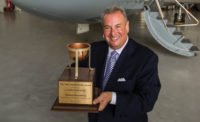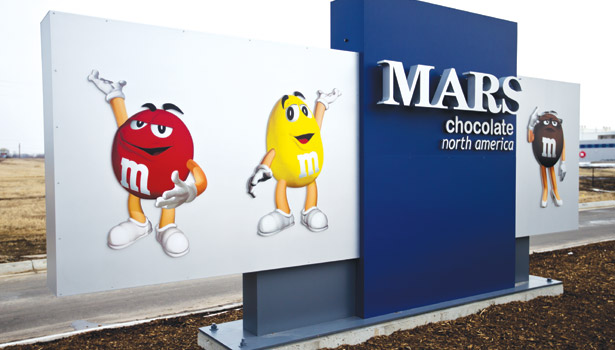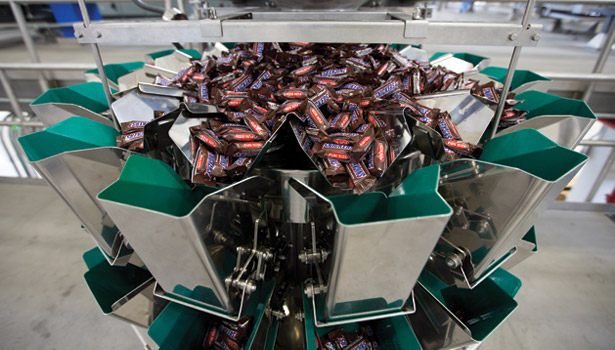Standing Tall In Topeka: An in-depth looks at Mars' first U.S. plant in 35 years
Designed to accommodate growth for the next 50 years, the $270 million, 500,000-sq.-ft. plant incorporates sustainable design and engineering elements.

A beaming Bret Spangler, site director - Topeka, Mars Chocolat eNorth America, in front of an eye-opening entryway at the company's newest manufacturing facility.


A SNICKERS line capable of producing FUN SIZE and mini-sized bars addressed capacity needs for the company.

Startup of the new SNICKERS line took only 12 days, from the time the product was introduced to the time it was inspected, a new record for Mars Chocolate North America.


A rail spur provides an economical delivery option for the plant. In total, the rail spur can hold up to 45 cars.

Bret Spangler, site director - Topeka, Mars Chocolate North America, says the construction of a rail shed provides year-round, all-weather unloading capabilities.

Holding tanks for corn syrup and other ingredients are suspended from above, thus allowing easier sanitation and maximizing hygiene.

Spangler explains to Candy Industry's Bernie Pacyniak the processing of cocoa liquor by one of two mixing, refining, and conching units in the plant.


Eight form/fill/seal bagging units handle packaging of SNICKERS FUN SIZE bars coming off the line.

A worker checks on filled cartons as they head toward a robotic pick n' place unit.

Cartons feed into a robotic pick'n place unit that fills the boxes with the correct number of bags.

Robotic units (background) help with the palletizing of cartons, which are then moved to a staging area for eventual shipping.

Bret Spangler, site director for Topeka, discusses the challenges and thrills involved with running Mars Chocolate North America's first "greenfield" facility in 35 years.

A wall of windows greets employees taking time out for lunch. Even the cafeteria's menu has been "enlightened" to feature healthier options.

A wall of windows greets employees taking time out for lunch. Even the cafeteria's menu has been "enlightened" to feature healthier options.

A volumeteric mixing line combines all the colors of Peanuts M&Ms together before they are conveyed to baggers.


















As the car approaches the building — a colossal combination of glass and concrete — it quickly becomes evident that this is a Mars Chocolate North America manufacturing facility. The large plastic M&M’S Characters protruding from the outside walls immediately convey the message that candy is produced here.
That message is reinforced upon coming to the front door where a bright, green, 36-ft. diameter wide M&M’S branded canopy shelters Mars associates and visitors from the Kansan elements. Once security clears the visitor, a familiar layout takes charge, an open area consisting of individual desks without walls — it’s a Mars trademark throughout the globe.
But this is the plant of the future, so there are quite a few new bells and whistles. For example, the cafeteria is located in an expansive hall, which has one large wall of windows providing a view of the buffalo grass seeded landscape inherent to the Great Plains.
Daylight pours into the cafeteria uninhibited, a precursor of what visitors find in the manufacturing areas. Bret Spangler, site director – Topeka, Mars Chocolate North America, explains that even the menu in the cafeteria has also been “enlightened” to include healthier choices. It’s just one of the many elements that went into the design and construction of the company’s newest flagship.
Aside from the two-year process to select the site (see accompanying sidebar), the company was just as meticulous in taking into account its commitment to sustainability, from pouring the first slab, to ensuring a renewable energy source.
As Spangler points out, the company designed the facility with the intent to attain LEED (Leadership in Energy and Environmental Design) certification. It certainly influenced the installation of 70 skylights and 270 windows, as well as the fact that one-third of all materials used were recycled.
Even during construction, which met both budget and scheduling targets, the emphasis was on sustainability. Hence, there was zero waste to landfill. For example, even the “first slab” was churned up to produce gravel, says Spangler.
Another major influence involved capacity.
“Mars has certainly grown the business and the major reason to build this new facility was capacity,” Spangler says. “We’ve exceeded capacity at all our nine other facilities in North America. We wanted to address current needs as well as those for the next 50 years.”
So, as the square footage indicates, the plant is big. The two lines that have been installed, a SNICKERS line for FUN SIZE and mini-sized products, and a peanut M&M’S line, address immediate capacity issues for those products. In addition, there’s room for three additional lines. Naturally, all the infrastructure to accommodate those lines is already in place.
Take, for example, chocolate production. Yes, the company receives regular shipments of chocolate liquor from its Elizabethtown facility in Pennsylvania. Once the tankers are unloaded, the chocolate is fed into one of two mixing, refining and conching systems.
Other raw ingredients, such as corn syrup, are delivered by rail via a rail spur. An enclosed rail shed capable of housing nine cars allows unloading of ingredients year-round, regardless of weather conditions. All ingredients are pumped from the shed to holding tanks within the plant.
One of the unique features of the tanks involves the way they are set up. Instead of resting on the ground, the tanks, which range from 30,000- to 50,000-gallon capacity, are literally suspended from above, resting on steel cross beams. Although this technique has been used before in Mars facilities, Spangler says, it’s never been done to the scale as in Topeka.
Sanitation, hygiene and energy conservation are themes that repeatedly come into play through the facility. From an epoxy floor that looks like terrazzo, to boxed-in support beams that minimize dirt accumulation, the emphasis is on easy-to-clean.
|
Betting on the nation’s bread basket It took two years. The site selection group visited 17 states and 80 potential sites. In the end, it chose 150 acres just south of the Topeka Regional Airport in Kansas. What prompted Mars Chocolate North America to select Topeka to build its first new candy manufacturing plant as opposed to anywhere else? Well, it wasn’t just the givens — a flat piece of land close to rail, road and air; local and state incentives; and a good talent pool — that played a key role, says Bret Spangler, site director – Topeka, Mars Chocolate North America. In this instance, the community fit Mars’ “culture” profile like, well, a well-wrapped candy bar. “The culture within the community matched well with our five principles – quality, responsibility, mutuality, efficiency and freedom,” Spangler says. You could see early on that the community leadership, as well as the workforce, was a great fit for Mars.” Of course, Midwestern values, such as a strong work ethic, honesty, charity, lack of pretense, and respect for family, dovetail nicely with Mars’ five principles. In addition, Midwesterners — especially given this past winter — tend to be a weathered bunch, be it from a meteorological or lifestyle point of view. So it takes more than a few overhyped storm warnings to make them pack up and go. They are definitely long-term folk. Values are one thing, but what about skills? Did the Topeka area have a labor pool that was not only mechanically inclined but had a good grasp of engineering and computer concepts? Again, Mars did its homework. Prior to selecting Topeka, the company interviewed other manufacturing companies located in the area, which include such CPG companies as Frito-Lay, Del Monte Foods, U.S. Foods, Reser’s Foods, Bimbo Bakeries and Hill’s Pet Nutrition. And while everyone had perpetual openings for maintenance technicians, the overall consensus indicated that there was a good mix of semi-skilled and skilled workers in the area. Interestingly enough, when it came to interviewing prospective candidates for openings at the new plant, the overwhelming determination came down to whether candidates met “cultural” requirements as compared to “functional” skills. And while Spangler admits the strategy meant taking a bit of a risk, the decision paid off “huge dividends.” “We wanted people that were engaged to get the job done, that were driven by continuous improvement, and empowered to make a decision. We don’t want our associates to check their brains at the door. We want them to make decisions and take risks.” The move seems to have worked since the startup of the SNICKERS FUN SIZE line took only 12 days, from the time they introduced product to the time it was inspected — a record for the company. |
Spangler points to the cooling tunnel on the SNICKERS line that spans several hundred feet long. Instead of two “feet” of supports, there’s only one support every 30 feet. In addition, there are no liquid or processing lines crossing over the SNICKERS production line.
The site director points out how the design of the plant tries to minimize associate traffic coming into contact with fork lift vehicles.
“There’s a catwalk that will get you to our SNICKERS as well as the M&M’S production lines,” he explains. “Within the center of the production area is our main production office. Within that hub we have a maintenance shop, a training classroom and an open training class room, where we can wheel in equipment for instructional purposes.”
So what powers the plant? Here, too, the company was able to negotiate an agreement with the state to acquire all its electrical energy from a wind farm in western Kansas.
“We have 100 percent sustainable energy,” Spangler says. “We’re also focused on heat recovery in our boilers and compressors so we can capture heat loss and use that energy to heat our water systems.”
The company also installed a rainwater harvesting system that collects water into an underground reservoir. That water will be used to irrigate the flower beds. Otherwise all other landscaping, which consists of seeded buffalo grass, will be left to nature.
And what about the actual production of candies?
Well, the SNICKERS line, which has been targeted for the production of FUN SIZE and mini product sizes, isn’t “mini” at all. It can turn out 6 million FUN SIZE or 14 million mini pieces a day.
It all begins with the mixing of nougat. Once the layer of nougat is poured out onto a steel band, the initial SNICKERS layer is cooled. After which, a layer of peanuts and caramel is added, which also undergoes cooling. The two-layered slab is then conveyed to a slitter, which produces 45 rows of SNICKERS candy. The rows pass through a guillotine cutter, which quickly creates a virtual army of the candies. The pieces are then enrobed and travel through a 200-ft. cooling tunnel.
After cooling, the SNICKERS head toward eight high-speed flow wrappers capable of running fun-sized pieces at 950 pieces per minute and minis at 1,300 per minute. Once wrapped the pieces are conveyed toward several scaling units that feed baggers, which operate at 100 bags per minute.
The pick ‘n place robotic units take the bags and put them in cartons coming from a carton-former that feeds the line. Once packed, the cartons are sealed and transferred onto pallets for palletizing. Palletizing robots then place the cartons onto pallets, which are shrink-wrapped and staged for shipping.
As expected, Peanut M&M’S production starts with roasting. The roasting unit is segregated from the other production areas and all workers leaving the area must change their shoes and outerwear to enter a non-allergen area in the plant.
Once roasted, the peanuts are coated in chocolate. A colored candy shell is applied to the candies and then they are polished. After hardening, the M&M’S are conveyed to a volumetric mixing line that combines all the colors together. The pieces are then conveyed to printing machines that stamp the famous “M” on the candies.
The imprinted pieces head toward a bank of form/fill/seal baggers that first scale the pieces prior to bagging. After bagging, the robotic pick ‘n place units place the bags into pre-formed cartons. Upon sealing, the cartons head toward the palletizing area and then subsequent staging.
Spangler points out that the plant is still in the “tweaking” stage of production, making adjustments here and there to improve efficiencies and reduce waste while ensuring the highest quality standards.
To better ensure that newly hired associates understand Mars’ famous five principles — quality, responsibility, mutuality, efficiency and freedom — 20 percent of the workforce in Topeka are Mars’ existing associates who requested to make the move to Topeka.
It’s the company’s way of “seeding the culture” amongst the new associates, explains Spangler. And despite the company setting a record for starting up the SNICKERS line in 12 days, expectations are high for the flagship plant to hit efficiency, quality and waste numbers.
The plant may be in Kansas, but the expectations are world-class and Oz-like.
At-a-Glance: Mars Chocolate North America
Headquarters: Hackettstown, N.J. Topeka, Kan., Facility
Plant Size: 500,000 sq. ft. |
Looking for a reprint of this article?
From high-res PDFs to custom plaques, order your copy today!























